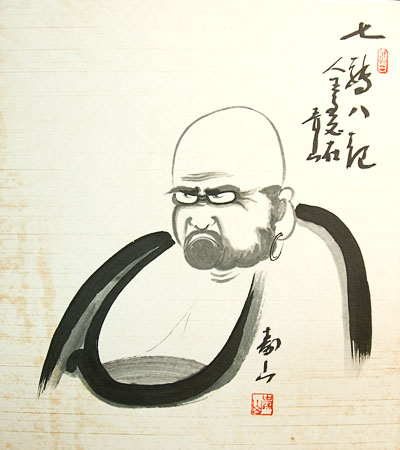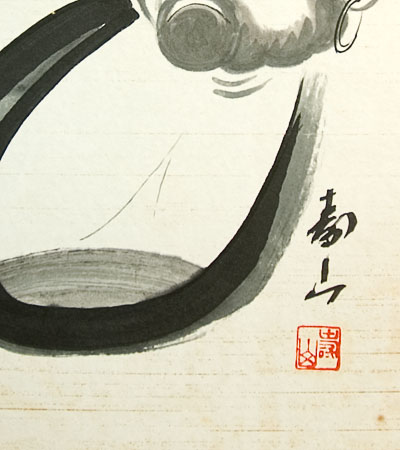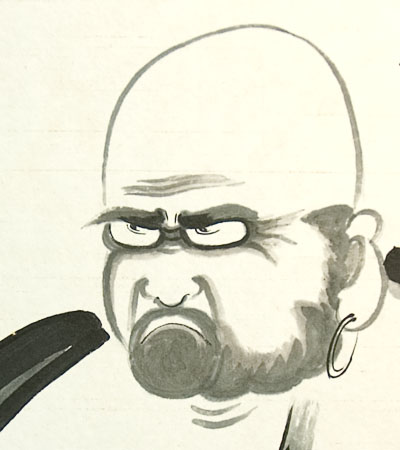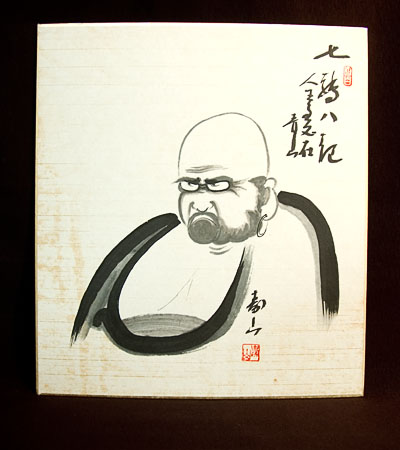



Description
Antique Japanese ink and wash painting featuring the image of the Zen Buddhist monk Daruma. This form of painting is also sometimes called simply ‘wash’ painting and in Japanese is called sumi-e or suibokuga painting. Using only brush-applied black ink on paper this type of painting was introduced into Japan in the 14th century by Zen Buddhist monks visiting from China. This type of art is especially well suited to Japanese tastes which tend toward subtle depictions of life and nature often accented with poetry written in beautiful calligraphy.
About the Listed Item
This original Japanese painting (nihonga) dates from the mid to late Japanese Showa period (1926-1989) and was done on a rectangular sheet of stiff Japanese shikishi paper with gold trim at the edges. The art features a stylized profile of the famous Buddhist monk Daruma, a wandering Indian priest who is credited as the founder of the Zen sect of Buddhism. This nihonga painting is in poor to fair condition with marks and stains and is a wonderful candidate for framing and display. Please read below to learn more about Daruma.
Size:
Height: 10.5 inches (27.0 centimeters)
Width: 9.4 inches (24.0 centimeters)
Click here to see other Daruma items!
Click here to see more Japanese art!
Click here to see additional treasures from Japan!
More about Daruma
“Life falls down seven times, yet gets up eight…” This popular Japanese proverb is commonly associated with the Indian Buddhist sage Daruma. Daruma is the more familiar name of the historical Buddhist monk Bodhidarma, who lived sometime during the fifth or sixth century AD. Daruma is credited with the founding of the Zen sect of Buddhism, which he is reputed to have introduced into China during his travels there. Some of the legends surrounding this figure include tales that he achieved enlightenment or satori only after meditating in a cave for seven years without blinking or moving his eyes. Another story tells that his enlightenment occurred within a temple in China where he spent his seven years sitting in a room staring at a wall. Apparently at some point during his long meditation Daruma became so overcome with fatigue that he cut off his eyelids in anger and tossed them to the ground. These are reputed to have then sprouted into China’s first green tea plants! It is said that Daruma’s long meditation caused his arms and legs to wither and fall off, leaving him as an armless, legless and eyelidless (yet enlightened) Bodhidarma… The Japanese love this story and admire Daruma for his spirit and determination, and each new year many Japanese will buy a paper-mache Daruma tumbler doll in order to enlist its services in helping them persevere towards their own goals or achievements. The dolls are sold with unpainted eyes, allowing the new owner to paint in one eye to symbolize the start of a new goal or venture. The doll is then placed in a prominent place within the home or at work in order to remind the owner to keep after their aim. Japanese students especially utilize Daruma to motivate them with their studies; placing a one-eyed Daruma before them on their desk as motivation to work hard and make the grade. Only after the goal is achieved will the owner then paint in the second eye, symbolizing a realized goal. Daruma dolls which have completed their jobs as perseverance role models are normally then brought to a temple to be burned during special ceremonies set aside for this purpose. The last images below are various representations of Daruma found at a Zen temple near our home in Japan.
item code: R3S1B1-0004094
category code: nihonga
ship code: shikishihako
Leave a comment